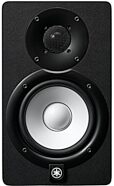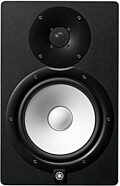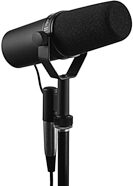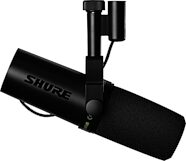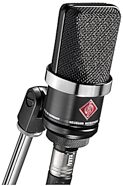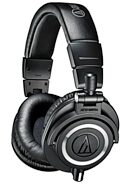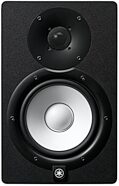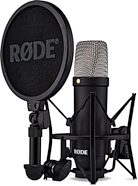Event EZBUS Audio Recording Interface With Digital Mixer
No longer available at zZounds
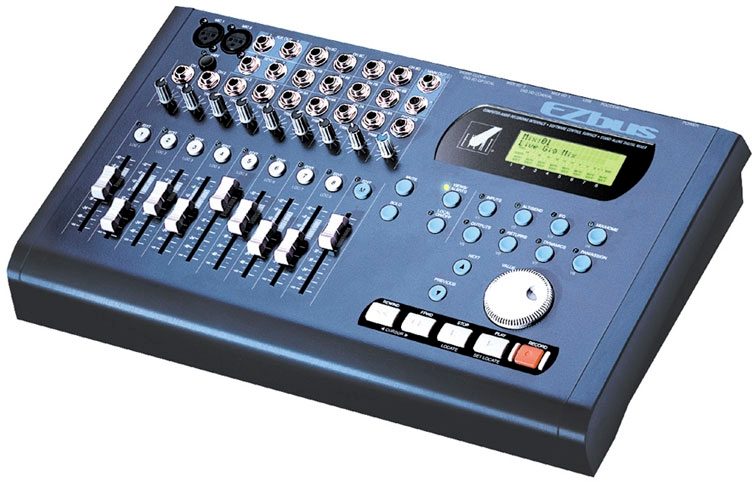

zZounds Gear Experts Say...
Gig bag-sized 24-bit digital mixer/interface/control surface.
Overview
As a stand-alone Digital Mixer, it provides 8 main input channels (four of which provide 3 inputs each), plus a USB port, 2 S/PDIF coaxial Inputs, one output, and S/PDIF/ADAT-format optical I/O. Main input channels provide dynamics processing and 4-band EQ. Any input (analog OR digital) may be routed to ANY mixing channel (the same applies to the 4 returns) and you can even mix signals with different sample rates - up to 96K! Other I/Os include dual MIDI I/Os, Word Clock Out, and 2 Sends plus 2 Aux Outs, making it an ideal Hard Disk Recording Interface.
One button push is all it takes to instantly transform EZbus into a customizable Control Surface with support for major software programs. You could see a product like this on the horizon but it took the ingenious minds of Event Electronics to actually deliver.
The EZbus mix engine architecture provides 8 primary channels, each of which offers EQ and dynamics processing. The 8 channels can be fed from any hardware input, analog or digital. A channel's signal can be routed to multiple destinations, including the Main Mix bus, the Alt Mix bus, and any or all of the 4 Sends; these, in turn, can be routed to a variety of hardware outputs. The EZbus also has 4 Return busses, which can function as additional input channels. This provides you with a total of 12 input channels, 8 of which support EQ and dynamics processing.
In a typical computer-based recording environment, many of the audio sources (keyboards, sound modules, drum… read more machines, effects devices, and the like) require little or no processing "after the fact;" that is, they don't necessarily need to have their tone, volume, or pan positions controlled at the mixer level. Rather, these functions can be performed by the device itself via internal settings or in response to MIDI commands. In that scenario, all that's required of the mixer is that it provide a means for the audio from the device to be brought into the main mix.
The EZbus was designed to accommodate a large number of audio sources, not all of which would necessarily need to have their individual tone, volume, and pan positions controlled at the mixer level. On EZbus analog inputs 5, 6, 7, and 8, three input jacks (labeled A, B, and C) are provided for each input. The 3 jacks in each channel are summed (and electronically buffered), allowing you to connect up to 3 audio sources to a single input. You could, for example, bring the signals from 6 synthesizers into inputs 5A, 5B, 5C, 6A, 6B, and 6C. You could then bring the stereo returns from three outboard effects devices, for example, into inputs 7A and 8A for effect #1, 7B and 8B for effect #2, and 7C and 8C for effect #3. Altogether, that's 12 audio signals brought into the EZbus using only 4 audio channels.
Through the analog inputs, you can bring 16 signals into the EZbus; 4 additional signals from the digital inputs can be routed to the Mix bus or Alt bus via the 4 "virtual" returns. In this manner, you can bring a total of 20 signals into the EZbus. At a minimum, you can bring 8 signals into the EZbus, each of which can be independently processed with EQ and dynamics. These signals can be from either analog or digital sources.
Let's presume you're a solo performer doing a nightclub gig. You would likely have an assortment of sound modules, possibly a keyboard, a drum machine, some effects devices, your vocal mic, and, versatile musician that you are, an acoustic or electro-acoustic guitar. Your vocal mic would plug into analog input #1. Your guitar would go into analog mic input #2 (or instrument input #3 if it's electro-acoustic) Your drum machine could go into analog inputs #3 and #4 (presuming you want to run in stereo). Let's say you have 3 MIDI sound modules and you also want to run them in stereo; these would plug into analog inputs 5A and 6A, 5B and 6B, and 5C and 6C. Now for your 3 outboard effects devices (a reverb, a vocal harmonizer, and a digital delay line, for example): Let's run them stereo as well, and plug all 3 into analog inputs 7A and 8A, 7B and 8B, and 7C and 8C. The last item is your keyboard, which features an S/PDIF output. It plugs into either the EZbus's coaxial or optical S/PDIF input.
Let's say you're also using a computer loaded with MIDI and audio sequences. Its stereo output would come into an EZbus Return (routed to the Main mix bus) via USB.
Altogether that's 2 monophonic instruments, 5 stereo instruments, 3 stereo effects devices, and a stereo mix from your laptop, for a total of 20 audio signals. In this configuration you would have independent control of volume, pan, EQ, and dynamics over your vocal mic, guitar, and drum machine. The sound modules would be grouped, with the EZbus's channel volume, pan, EQ, and dynamics settings affecting all 3 devices equally. Similarly, the effects devices would be grouped, with the EZbus channel settings affecting all 3 devices equally. The keyboard and computer would simply return directly to the Mix bus, with no EZbus channel-level processing on either; their settings would be controlled at the source.
Let's say you want to use your software "virtual" synths for live performance. Here's what you do: First, connect your computer or laptop to the EZbus via USB. Next, connect the MIDI out of your controller keyboard to either of the MIDI inputs on the EZbus. Now, when you play a note on your controller, that MIDI signal goes out of EZbus via USB and triggers the virtual synth. Here's where it gets fun: The audio from the virtual synth comes back into a couple of EZbus channels via USB, and that signal is mixed with your regular hardware synths (which are plugged into other EZbus channels). Your entire keyboard rig - real and virtual - is now a single, integrated system!
The EZbus offers 2 ways to bring audio digitally into a PCI-based system: via S/PDIF and via ADAT light pipe. Simply connect one of the S/PDIF outputs to an S/PDIF-equipped PCI card, or the ADAT optical output to the ADAT optical input on a Lightpipe-equipped PCI card. You can use the ADAT, S/PDIF, USB, and analog outputs simultaneously.
Independent programmable dynamics (compressor/expander/gate) are provided on each primary audio channel and on the Main Mix. The EZbus also has independent four-band EQ on each primary audio channel and on the Main Mix, comprising sweepable high and low shelving plus 2 fully parametric bands. All parameters of all functions are independently programmable and simultaneously available.
In addition to USB, the EZbus offers 2 ways to bring audio digitally into a computer system equipped with a PCI-based audio interface: via S/PDIF and via ADAT light pipe. Simply connect one of the S/PDIF outputs to an S/PDIF-equipped PCI card, or the ADAT optical output to the ADAT optical input on a Lightpipe-equipped PCI card. You can use the ADAT, S/PDIF, USB, and analog outputs simultaneously. (Note: Contact the manufacturer of the PCI card of your choice to verify its compatibility with your computer.) read less
One button push is all it takes to instantly transform EZbus into a customizable Control Surface with support for major software programs. You could see a product like this on the horizon but it took the ingenious minds of Event Electronics to actually deliver.
The EZbus mix engine architecture provides 8 primary channels, each of which offers EQ and dynamics processing. The 8 channels can be fed from any hardware input, analog or digital. A channel's signal can be routed to multiple destinations, including the Main Mix bus, the Alt Mix bus, and any or all of the 4 Sends; these, in turn, can be routed to a variety of hardware outputs. The EZbus also has 4 Return busses, which can function as additional input channels. This provides you with a total of 12 input channels, 8 of which support EQ and dynamics processing.
In a typical computer-based recording environment, many of the audio sources (keyboards, sound modules, drum… read more machines, effects devices, and the like) require little or no processing "after the fact;" that is, they don't necessarily need to have their tone, volume, or pan positions controlled at the mixer level. Rather, these functions can be performed by the device itself via internal settings or in response to MIDI commands. In that scenario, all that's required of the mixer is that it provide a means for the audio from the device to be brought into the main mix.
The EZbus was designed to accommodate a large number of audio sources, not all of which would necessarily need to have their individual tone, volume, and pan positions controlled at the mixer level. On EZbus analog inputs 5, 6, 7, and 8, three input jacks (labeled A, B, and C) are provided for each input. The 3 jacks in each channel are summed (and electronically buffered), allowing you to connect up to 3 audio sources to a single input. You could, for example, bring the signals from 6 synthesizers into inputs 5A, 5B, 5C, 6A, 6B, and 6C. You could then bring the stereo returns from three outboard effects devices, for example, into inputs 7A and 8A for effect #1, 7B and 8B for effect #2, and 7C and 8C for effect #3. Altogether, that's 12 audio signals brought into the EZbus using only 4 audio channels.
Through the analog inputs, you can bring 16 signals into the EZbus; 4 additional signals from the digital inputs can be routed to the Mix bus or Alt bus via the 4 "virtual" returns. In this manner, you can bring a total of 20 signals into the EZbus. At a minimum, you can bring 8 signals into the EZbus, each of which can be independently processed with EQ and dynamics. These signals can be from either analog or digital sources.
Let's presume you're a solo performer doing a nightclub gig. You would likely have an assortment of sound modules, possibly a keyboard, a drum machine, some effects devices, your vocal mic, and, versatile musician that you are, an acoustic or electro-acoustic guitar. Your vocal mic would plug into analog input #1. Your guitar would go into analog mic input #2 (or instrument input #3 if it's electro-acoustic) Your drum machine could go into analog inputs #3 and #4 (presuming you want to run in stereo). Let's say you have 3 MIDI sound modules and you also want to run them in stereo; these would plug into analog inputs 5A and 6A, 5B and 6B, and 5C and 6C. Now for your 3 outboard effects devices (a reverb, a vocal harmonizer, and a digital delay line, for example): Let's run them stereo as well, and plug all 3 into analog inputs 7A and 8A, 7B and 8B, and 7C and 8C. The last item is your keyboard, which features an S/PDIF output. It plugs into either the EZbus's coaxial or optical S/PDIF input.
Let's say you're also using a computer loaded with MIDI and audio sequences. Its stereo output would come into an EZbus Return (routed to the Main mix bus) via USB.
Altogether that's 2 monophonic instruments, 5 stereo instruments, 3 stereo effects devices, and a stereo mix from your laptop, for a total of 20 audio signals. In this configuration you would have independent control of volume, pan, EQ, and dynamics over your vocal mic, guitar, and drum machine. The sound modules would be grouped, with the EZbus's channel volume, pan, EQ, and dynamics settings affecting all 3 devices equally. Similarly, the effects devices would be grouped, with the EZbus channel settings affecting all 3 devices equally. The keyboard and computer would simply return directly to the Mix bus, with no EZbus channel-level processing on either; their settings would be controlled at the source.
Let's say you want to use your software "virtual" synths for live performance. Here's what you do: First, connect your computer or laptop to the EZbus via USB. Next, connect the MIDI out of your controller keyboard to either of the MIDI inputs on the EZbus. Now, when you play a note on your controller, that MIDI signal goes out of EZbus via USB and triggers the virtual synth. Here's where it gets fun: The audio from the virtual synth comes back into a couple of EZbus channels via USB, and that signal is mixed with your regular hardware synths (which are plugged into other EZbus channels). Your entire keyboard rig - real and virtual - is now a single, integrated system!
The EZbus offers 2 ways to bring audio digitally into a PCI-based system: via S/PDIF and via ADAT light pipe. Simply connect one of the S/PDIF outputs to an S/PDIF-equipped PCI card, or the ADAT optical output to the ADAT optical input on a Lightpipe-equipped PCI card. You can use the ADAT, S/PDIF, USB, and analog outputs simultaneously.
Independent programmable dynamics (compressor/expander/gate) are provided on each primary audio channel and on the Main Mix. The EZbus also has independent four-band EQ on each primary audio channel and on the Main Mix, comprising sweepable high and low shelving plus 2 fully parametric bands. All parameters of all functions are independently programmable and simultaneously available.
In addition to USB, the EZbus offers 2 ways to bring audio digitally into a computer system equipped with a PCI-based audio interface: via S/PDIF and via ADAT light pipe. Simply connect one of the S/PDIF outputs to an S/PDIF-equipped PCI card, or the ADAT optical output to the ADAT optical input on a Lightpipe-equipped PCI card. You can use the ADAT, S/PDIF, USB, and analog outputs simultaneously. (Note: Contact the manufacturer of the PCI card of your choice to verify its compatibility with your computer.) read less
Specs
Computer Audio Recording Interface
18 analog inputs (14 TRS balanced line inputs, 2 mic preamps with +48V phantom power, 2 instrument/line inputs)
24-bit/96kHz analog-to-digital and digital-to-analog conversion
Optical I/O for ADAT Lightpipe and S/PDIF (automatically senses source type)
Coaxial S/PDIF input
Two independently assignable coaxial S/PDIF outputs
8 independent analog outputs (Main Mix Output L/R, Aux Output L/R, Sends 1 & 2, Headphone Output L/R)
Audio recording via USB on Macintosh or PC computers; USB operation provides full-duplex 2-channel 24-bit/48kHz recording/playback
2 independent MIDI inputs and outputs, plus a third virtual I/O port for EZbus-specific communication
Word clock output
Programmable footswitch jack (punch-in, Mix advance, etc.)
Hot-swappable; requires no IRQ (just plug it in and go!)
Software Control Surface
Fully programmable front-panel faders, switches, encoder knob, and transport controls for sending MIDI Controller data via USB and the dual dedicated MIDI outputs
Presets for Cubase 5 (Mac/PC), Nuendo (PC), and Cakewalk (PC) included for controlling most mixing functions, including volume, pan, send levels, mute, and solo
Front panel Localizer (Local On/Off) button for instant switching between onboard audio mixing and control surface mode
Four selectable fader response operation modes; Actual, Null, Relative, and Smoothing
Transport controls with jog/shuttle wheel for controlling sequencers as well as any MMC device
Set and recall up to 8 Locate points
Stand-Alone Digital Mixer
Eight primary audio channels; source signal from any analog or digital input
4 virtual audio channels (source signal: EZbus Returns)
4 multi-input analog channels; accept up to three independent source signals per channel
EZbus Audio Routing Matrix provide super-flexible input/output routing
4-band EQ on each primary audio channel and on Main Mix; sweepable high and low shelving plus 2 fully parametric bands
Programmable dynamics (compressor/expander/gate) on each primary audio channel and on Main Mix
Mute and Solo on each primary audio channel
Save and recall 32 internal snapshots of all mix and system parameters
2 mono Returns and one stereo Return; Returns may be used as additional inputs
4 Sends per channel, independently assignable pre- or post-fader
Supports multiple bit-resolutions and sample rates up to24-bit/96kHz
Asynchronous sample-rate support via S/PDIF with high quality sample-rate conversion.
AudioAlert function notifies user of errors, such as overloading an analog input, digital dropouts, or clipping due to excessive EQ.
ADAT Lightpipe output functions as direct outputs for primary mixer channels (for use as a front end for an ADAT or Lightpipe-equipped audio card)
Lightpipe output channels can also be independently assigned as Main Mix outputs, Alt Mix Outputs, and Sends
USB port can be used for Main and Alt Mix buses, Channel inputs, Sends, and Returns
18 analog inputs (14 TRS balanced line inputs, 2 mic preamps with +48V phantom power, 2 instrument/line inputs)
24-bit/96kHz analog-to-digital and digital-to-analog conversion
Optical I/O for ADAT Lightpipe and S/PDIF (automatically senses source type)
Coaxial S/PDIF input
Two independently assignable coaxial S/PDIF outputs
8 independent analog outputs (Main Mix Output L/R, Aux Output L/R, Sends 1 & 2, Headphone Output L/R)
Audio recording via USB on Macintosh or PC computers; USB operation provides full-duplex 2-channel 24-bit/48kHz recording/playback
2 independent MIDI inputs and outputs, plus a third virtual I/O port for EZbus-specific communication
Word clock output
Programmable footswitch jack (punch-in, Mix advance, etc.)
Hot-swappable; requires no IRQ (just plug it in and go!)
Software Control Surface
Fully programmable front-panel faders, switches, encoder knob, and transport controls for sending MIDI Controller data via USB and the dual dedicated MIDI outputs
Presets for Cubase 5 (Mac/PC), Nuendo (PC), and Cakewalk (PC) included for controlling most mixing functions, including volume, pan, send levels, mute, and solo
Front panel Localizer (Local On/Off) button for instant switching between onboard audio mixing and control surface mode
Four selectable fader response operation modes; Actual, Null, Relative, and Smoothing
Transport controls with jog/shuttle wheel for controlling sequencers as well as any MMC device
Set and recall up to 8 Locate points
Stand-Alone Digital Mixer
Eight primary audio channels; source signal from any analog or digital input
4 virtual audio channels (source signal: EZbus Returns)
4 multi-input analog channels; accept up to three independent source signals per channel
EZbus Audio Routing Matrix provide super-flexible input/output routing
4-band EQ on each primary audio channel and on Main Mix; sweepable high and low shelving plus 2 fully parametric bands
Programmable dynamics (compressor/expander/gate) on each primary audio channel and on Main Mix
Mute and Solo on each primary audio channel
Save and recall 32 internal snapshots of all mix and system parameters
2 mono Returns and one stereo Return; Returns may be used as additional inputs
4 Sends per channel, independently assignable pre- or post-fader
Supports multiple bit-resolutions and sample rates up to24-bit/96kHz
Asynchronous sample-rate support via S/PDIF with high quality sample-rate conversion.
AudioAlert function notifies user of errors, such as overloading an analog input, digital dropouts, or clipping due to excessive EQ.
ADAT Lightpipe output functions as direct outputs for primary mixer channels (for use as a front end for an ADAT or Lightpipe-equipped audio card)
Lightpipe output channels can also be independently assigned as Main Mix outputs, Alt Mix Outputs, and Sends
USB port can be used for Main and Alt Mix buses, Channel inputs, Sends, and Returns
No longer available at zZounds
In most cases, a product is unavailable because it has been discontinued by the manufacturer
This is a carousel with product cards. Use the previous and next buttons to navigate.


